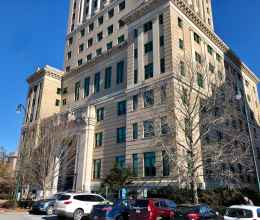Would you still go to a protest if it meant you might be beaten, shot, attacked by dogs, pepper sprayed, or even killed? Would you still choose to speak out for what you believe?
The ACLU of North Carolina partnered with the Raleigh Murals Project and commissioned award-winning artist Dare Coulter to create a mural in downtown Raleigh that pays tribute to the First Amendment and the courage of those who have exercised their right to protest throughout history, often in the face of violence.
Below the artist, Dare Coulter, answers our questions and tells the story of how the mural at 210 S. Salisbury Street came to be, and why it is so important today.
Q: How did this project come about?
Dare Coulter: I was contacted by Jessica (Jessica Turner, ACLU-NC Faith & Community Engagement Coordinator) and Jed (Jedidiah Gant with the Raleigh Murals Project), and we brainstormed ideas for what this mural could look like. They gave me the freedom to come up with a few concepts, and I drew up some sketches. We decided that this one could resonate with the most people and started working on logistics.
Q. What made you want to take on this project?
Dare Coulter: When the ACLU of North Carolina and Raleigh Murals Project contacted me about creating a public mural celebrating the First Amendment, I was immediately excited. I have been working toward having a permanent outdoor mural for years. This mural is about how important it is to protect our right to protest; it is a tribute to the courageous people featured in it; and it is a memorial to everything they risked to stand up for what they believe.
Q. Who is featured in the mural?
Dare Coulter: When I started to create the concept for this mural, I looked for incredible moments of bravery. For many people in my mural, there wasn’t a guarantee they would make it home safely. They put their lives on the line while exercising their right to protest.
The mural features iconic imagery from some of the more famous protest in history including the 1968 Olympic Black Power Salute of American Olympians Tommie Smith and John Carlos. Bloody Sunday, when non-violent African American protesters in Selma were sprayed with tear gas, beaten and clubbed, and attacked by police dogs. The Stonewall Riots, which helped launch the LGBTQ Pride movement. The 1968 Memphis Sanitation Workers’ Strike, more commonly known as the “I Am A Man March.” Dolores Huerta, who was a civil rights leader, labor activist, and co-founder of United Farm Workers, which advocated for the social and economic rights of farm workers and Hispanic Americans. “Tank Man” from the 1989 Tiananmen Square protest where hundreds of protesters were killed by military troops.
I also featured some more modern protest iconography like Iesha L. Evans, frequently referred to as Tank Man’s modern counterpart, who was arrested at a Baton Rouge Black Lives Matter protest just days after a police officer shot and killed Alton Sterling. Feyisa Lilesa, an Ethiopian Olympian who is living in political asylum in the U.S. for fear of being killed if he returns home after he crossed his arms above his head at the finish line in a defiant gesture against Ethiopia’s repressive government. An unnamed Indian woman protesting the response to the brutal rape and murder of Jyoti Singh. A Native American woman from the #NoDAPL protest at Standing Rock. The wonderful women of the LeChevallier family and their pink hats whom I met at the Women’s March in January. And of course the social media sensation “Woke Baby,” photographed in Charlotte, NC during the Women’s March as well.
Q. Why is the mural important?
Dare Coulter: It is important to remember all the people who protested in a time when dissent could have meant death, and it is also important to stand up for the people who still do that today.
For many protests today, there isn’t a threat of bodily harm, and the people who come to protests don’t do so thinking they might die just for showing up. That means that we have come a long way, but that also means there are lots of people who don’t understand that protests didn’t always happen that way.
The people in this mural didn’t march for a Facebook post. They didn’t pour onto the streets so they could look “woke” on their Instagram feeds. They did it because their lives depended on it, and they did it knowing they were risking their freedom and livelihood for others.
Our right to join in protest is critical to a functioning democracy and at the core of the First Amendment. The right to free speech and the freedom to stand up for what you believe in includes our right to dissent – to express views that may be unpopular, controversial, or against the status quo.
That’s what protesters do: we dare to dissent.
This mural is a reminder of how important it is to protect and exercise this fundamental Constitutional right for all. When “We the People” come together to voice our dissent, we can create change.
